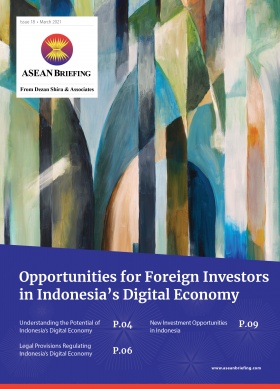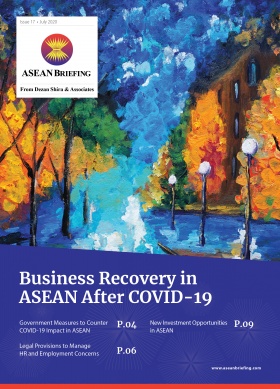Opportunities for Australian Wine in ASEAN
- In 2020, Asia’s wine markets brought in US$1.7 billion for Australian wine producers and importers.
- Australia’s wine industry is currently experiencing a loss of access to China’s US$887 million market – due to high tariffs as a result of geopolitical issues and lower profits because of COVID-19.
- Vietnam is one of the most promising ASEAN countries for the Australian wine industry – the westernization of tastes combined with increased tourism and a growing middle class make the country a highly attractive market.
In 2020, the Australian wine industry’s profits were estimated to be US$2,9 billion; in 2023, they are expected to reach US$3.6 billion. As of May 2020, Australian wine exports to Asia grew by 12 percent, compared to the previous year, while the ASEAN market grew by 18.8 percent.
According to Wine Australia, the national governmental corporation regulating the wine industry, one-fifth of the production is exported to Asia – accounting for US$1.7 billion in 2020. Alongside France, Italy, and Chile – Australia enjoys a positive reputation for the quality of its wines. Australian wines are even more competitive in the region as they are produced close to Asian markets.
Singapore and Hong Kong are devoted consumers of Australian wines but, China is the largest importer of the product, with a market of value US$887 million. However, recent geopolitical developments will significantly reduce imports.
In the meantime, ASEAN countries are emerging as key wine trading partners. In these low-price-sensitive markets, the popularity of Australian wine is growing as it becomes cheaper thanks to customs duties exemptions and free trade agreements. This growth is further supported by the increase of tourism in these regions, which counteracts religion-related factors that could shrink the number of potential consumers.As of 2020, the five largest ASEAN importers of Australian wines were Singapore (accounting for US$80 million), Malaysia (US$31 million), Thailand (US$17 million), the Philippines (US$11 million), and Indonesia (US$11 million).
Recently, Vietnam became the wine industry’s focus of interest. This transitional and promising alcohol market could become Australia’s strongest trade partner, to compensate for the loss of China, but also to mitigate the effects of the pandemic suffered by the industry. Vietnam still does have some strict import rules.
China: The top-market has become a dead-end
China is Australia’s top exporter by market value. Before 2019, Australia’s exports to China accounted for US$760 million a year. That figure fell to less than US$10 million for January 2021, due to an escalating trade war between the two countries.
A series of geopolitical events have undermined the trade links that existed before, and so have deeply impacted Australian wines’ revenues.
Drastic and punitive economic measures aimed to answer Australia’s political attacks against China were implemented. Tariffs have been increased towards Australia’s key exports. Wine imports have been subject to anti-dumping investigations since last August as Australian wine exports were said to be unfairly cheap. In November 2020, a 212 percent temporary retaliation tariff was applied, and thousands of liters of Australian wines were stopped at the Chinese custom borders. Currently, China has applied tariff rates of between 116.2 and 218.4 percent since March 2021 for Australian wine, which will be applied for five years.
ASEAN markets offer significant opportunities for Australian wine
ASEAN markets offer different characteristics and degrees of opportunity for Australian wine.
Malaysia, Thailand, the Philippines, and Indonesia are in the process of becoming reliable trading partners. The 2020 ASEAN market brought in US$156 million in revenue for Australian producers and exporters.
Cheap beer is highly popular in these countries but is increasingly competing with wines, as they have become less expensive thanks to duty exemptions.
In addition, a growing middle class is increasing the demand for higher-quality alcohol in ASEAN. Moreover, tourism in Malaysia, Thailand, Indonesia, and the Philippines also supports the growth of wine consumption.
Singapore and Hong Kong: Long-term stable markets and trading hubs
Singapore and Hong Kong have always been long-term consumers of wine thanks to their high-income and wine-educated population. Tourism has also contributed significantly to wine consumption in these regions.
Australian wines can easily enter their markets as they are exempted from customs duties supported by the implementation of the Singapore Australia Free Trade Agreement and the Australia Hong Kong Free Trade Agreement.
Singapore is Australia’s largest trade and investment partner in ASEAN, overtaking Hong Kong; however, Hong Kong remains the biggest consumer of wine in Asia as the average annual consumption is six liters per person.
Currently, 43 percent of Singapore’s market is dominated by French brands, while Australian brands enjoy a 25 percent share of the market. However, there is an increasing number of consumers moving towards Australian wine.
Alcohol is subject to an excise tax of US$88 per liter in Singapore, which is applied for all types of wines. An additional seven percent of goods and services (GST) is levied on the wine consumer. For its part, Hong Kong has abolished any VAT and GST on wine since 2008.
Singapore and Hong Kong not only serve as major importers and consumers of Australian wines but are also trading hubs for re-exporting products. Singapore is estimated to re-export some 30 percent of all its imported wines, whereas Hong Kong re-exports 37 percent of its wine products. These export markets include Japan, China, Taiwan, and Vietnam and thus also present opportunities for Australian suppliers.
Although Singapore and Hong Kong are profitable markets, the pandemic has affected Australian wine sales. A 12 percent drop in revenues was observed by Australian brands in Singapore – as a direct consequence of the government-imposed bar and shop closures. In Hong Kong, Australian imports have fallen by 40 percent at the beginning of 2020, in comparison to the previous year.
Malaysia
According to Wine Australia, a third of Malaysian wine imports originates from Australia. Revenues reached US$24 million in 2019. Under the Comprehensive and Progressive Agreement for Trans-Pacific Partnership (CPTPP), Australian wines should benefit from declining preferential rates that should reach the zero percent slab by 2034. Tariffs were at 34 percent in 2019. Malaysia is the second-largest consumer of wine in Asia, with a consumption of 26.7 million liters in 2020.
Thailand
Thailand’s wine is expected to grow steadily in the coming years. In 2020, Thailand consumed 103.3 million liters of wine, making it the largest consumer in ASEAN. The country is the second-largest wine importer of Australian wine, ahead of French products. Australian wines are more competitive in Thailand as they are duty-free since the inception of the 2005 bilateral FTA. Wines are subject to a seven percent VAT and to significant excise taxes by quantity and price.
However, beer is a fierce competitor as it represents 75 percent of total alcohol consumption – while imported wines only account for 1.5 percent, as indicated in a report from the Australian Department of Trade.
The Philippines and Indonesia
The Philippines and Indonesian markets are still relatively small for Australian wine providers, valued at US$5 million and US$14 million, respectively, in 2020.
Australian wine is exempted from customs duties in the Philippines under the Australia ASEAN New Zealand Free Trade Agreement (AANZFTA). Such imports are still subject to excise taxes – around one dollar per liter of wine – that will increase by six percent each year starting from 2021.
In Indonesia, preferential tariffs for wines have been excluded from the AANZFTA and the recent Indonesia-Australia Comprehensive Economic Partnership Agreement (IA-CEPA). Therefore, tariffs ranging from 90 to 150 percent are applied to Australian wines. What’s more, up to a US$1 excise tax per liter is charged on imported beverages containing more than 20 percent alcohol. Moreover, being a Muslim-majority country, Indonesia has one of the lowest alcohol consumptions in the world.
Tourism, however, could contribute to the growth of the alcohol market and compensate for religious practitioners. Muslim-majority Indonesia and Malaysia enjoyed over 40 million international visitors combined. Bali is one such tourist hot spot for alcohol consumption, especially wine.
An emerging and thriving Vietnamese wine market targeted by Australia
Tackling Vietnam’s burgeoning wine market is one of Australia’s strategies to cope with the losses incurred due to the pandemic. Alongside, it will establish a new, stable, and reliable trade partnership as China reduces its consumption of Australian wine.
The South Australian Wine Industry Association announced in 2020 its plan to look for new partners in ASEAN and diversify exports.
Why Vietnam is becoming a profitable wine market?
The Vietnamese wine market represents a significant opportunity for Australian importers and producers to tackle. Currently, it is said to be mainly held by French brands (at 35 percent) and Chile (at 25 percent), closely followed by Italian and Australian brands. The market brought US$5.3 million to Australia in 2020.
The alcohol competition in Vietnam is tough: wine competes with beer, which is cheap and very popular among all social categories. According to Vietnam Credit, beer accounts for 40 percent of the alcohol market share.
It should be noted that the appeal for more expensive and higher quality alcohol is growing. At the same time, Vietnam’s consumption of alcohol increased by 95 percent from 2010 to 2020, meaning market growth is solid, and opportunities are multiplying.
Vietnamese lifestyles have certainly not yet integrated wine into their consumption habits, but tastes and preferences are progressively westernized as the middle-class grows – three million people joined this group between 2014 and 2016. Vietnam already accounts for the third-largest ASEAN wine consumer market, as its consumption accounted for 15.3 million liters in 2020. According to the World’s Top Exports data, from 2018 to 2019, wine consumption increased by 173.6 percent,.
Currently, Vietnamese consumers show a preference for red wine, accounting for 76 percent of total sales in 2020, but wine rosé is also becoming more popular.
What are the tariffs and compliances applicable to exports to the Vietnamese market?
. There are several tariff and compliance regulations that suppliers should be aware of. These are:
- A US$50,000 import license for selling wine in Vietnam. The authorities grant liquor distribution and wholesaling licenses based on quotas.
- Advertising for the sale of wine is strictly regulated, as products with an alcohol content overcoming 15° cannot be mass-advertised and under 15° is restricted.
- Certificates and documents must be provided to public authorities to allow the import of wine in Vietnam – namely, but not only, a health certificate, a technical standard certificate, and a certificate of origin, in addition to product checking.
- A 50 percent import tax applies to all types of wines coming from Australia, resulting in preferential tariffs granted by the AANZFTA. Still, the Comprehensive and Progressive Agreement for Trans-Pacific Partnership (CPTPP) – to which Vietnam and Australia are signatories – will reduce tariffs to 20 percent in January 2022 and then to zero percent in 2029.
- A 65 percent Special Sales Tax (SST) is applied for wines with an alcohol content above 20 Any concentration under this is obligated to pay a 35 percent SST.
- A 10 percent Value Added Tax (VAT) on all kinds of liquor, including wines, sold on the Vietnamese territory.
About Us
ASEAN Briefing is produced by Dezan Shira & Associates. The firm assists foreign investors throughout Asia and maintains offices throughout ASEAN, including in Singapore, Hanoi, Ho Chi Minh City, and Da Nang in Vietnam, Munich, and Esen in Germany, Boston, and Salt Lake City in the United States, Milan, Conegliano, and Udine in Italy, in addition to Jakarta, and Batam in Indonesia. We also have partner firms in Malaysia, Bangladesh, the Philippines, and Thailand as well as our practices in China and India. Please contact us at asia@dezshira.com or visit our website at www.dezshira.com.








